|
|
How to Tie Fly Fishing Knots
In fly fishing, as in all fishing, the knot the
fisherman uses is crucial to success, as many of us have learned to our
cost. It is important to get our fishing knots right, in securing our backing
line to the reel; in connecting our backing line to the fly line; in
joining our fly line to our leader; and in tying on our fly. A number of
fly fishing knots are illustrated
below. These are the fishing knots I use in my trout, salmon and sea
trout fly fishing. They include popular knots like the perfection loop
knot and water knot as well as one or two new fishing knots like Gray's Loop,
a neat and simple method of attaching a leader loop to the end of a fly
line. |
Practical Fly Fishing Knots
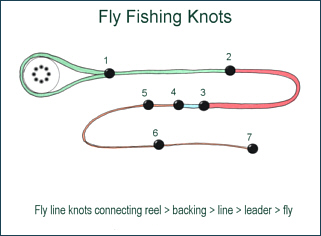
The
diagram above illustrate the following knots:
1
Reel Knot - for tying
the backing line to the reel
2
Constriction Knot - for
joining the backing (or nylon leader) to the fly line
3
Gray's Loop
- attaching
a nylon monofilament loop to the end of a fly line
4
Loop to Loop - a simple way of
connecting leader and fly line
5
Perfection loop - a reliable
leader loop
6
Water Knot - a simple and effective dropper knot
7
Slip Knot - a simple knot for
tying a hook or fly to a nylon leader |
REEL KNOT
This
is a simple and reliable knot which can be used to secure
backing line to the reel. For added security, take the
backing round the reel drum twice before tying the knot.
After pulling the slip knot tight, trim the loose end but
not too close to the knot.
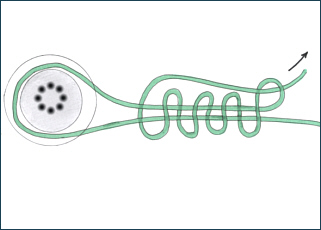 |
CONSTRICTION KNOT
This is a simple method of
attaching most types of backing line - nylon monofilament, dacron, braided terylene
or twisted nylon - to a
traditional type of fly line i.e. a PVC coated, terylene core fly line.
It should not be used with hollow braided nylon backing line, nor is it suitable for some modern lines
with multistrand or monofilament cores.
1 Overlap the fly line
and backing line by around 12 inches.
2 Take the end of the
backing line and fold it
over itself and the fly line to form a loop and grip the point of
overlap (A) firmly between the thumb and forefinger of the right hand.
3 Bring the end of the backing
through the loop half a dozen times times.
4 Carefully draw the
turns together while sliding the whole knot
towards the tip of the fly line. With the turns of the knot touching, pull steadily on
both ends of the backing until the knot grips the fly line tightly. Check the security of
the knot by pulling the backing and fly line firmly in opposite directions. When
satisfied, trim the ends closely.
This knot can also be used to tie a
nylon leader directly to the end of a braided core fly line.
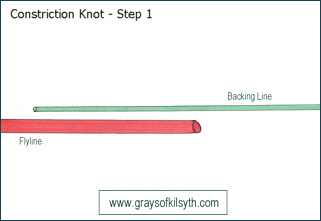
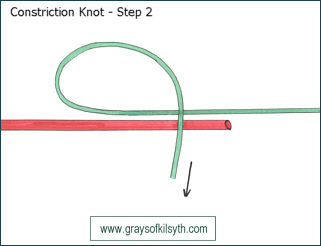
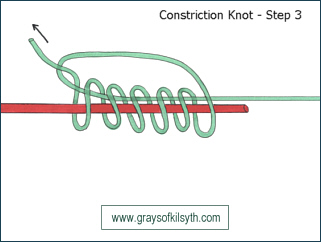
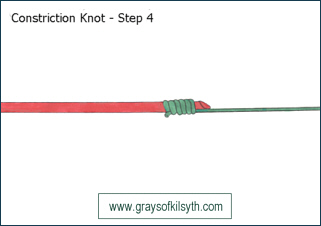 |
PERFECTION
LOOP
A reliable leader
loop which lies in line with the leader. The loose end can
be trimmed very close to the knot. Not as difficult as it
seems at first sight.
Use the thumb and
forefinger of the left hand to grip the knot while
manipulating the loop with the right hand.
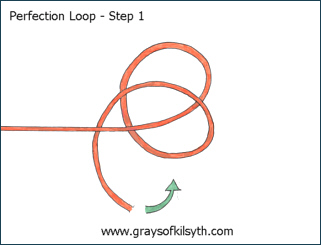
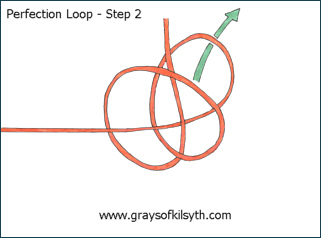
|
SLIP KNOT
I have used this knot for many
years as an alternative to the half - blood knot. It is similar to
the Grinner knot. moisten and tighten the knot well and don't trim
too close to the hook.
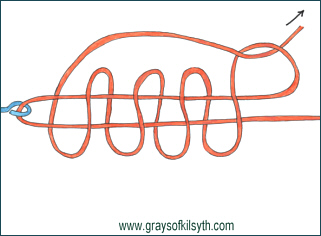
|
|
|
|
GRAY'S LOOP
Gray's Loop is a version of
the
Constriction knot used to attach a semi-permanent loop of nylon monofilament to the end of
a traditional PVC coated, terylene core flyline. This nylon loop facilitates a loop to loop connection
with the fly leader. Such a loop might last a whole season before
needing replaced.
Quick Grays Loop
Follow
the same procedure as for the Constriction knot, but with a doubled length of monofilament
nylon. Starting with a length of about 18 inches [half a metre] of nylon
makes it easier to pull the knot tight. Also start with as small a
loop as possible, held between the right thumb and forefinger [figure
1], if you want to create a small loop [although a loop of anything up
to around three inches long works fine]. Use a minimum of three turns. Carefully draw the knot together while sliding the whole knot
towards the end of the fly line. With the turns of the knot touching, pull steadily on
both ends until the knot grips the fly line tightly. Check the security of
the knot by pulling steadily with a finger in the loop. When
satisfied, trim the ends closely.

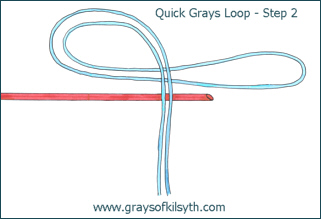

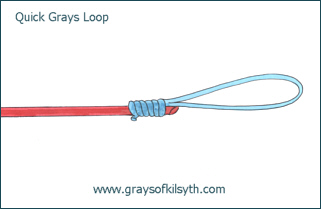
The strength of the nylon will
vary with the weight of fly line and breaking strain of leader. As a
guide I use the following :
|
FLY LINE
|
LEADER
b.s. lbs
|
LOOP
b.s.
|
|
5 |
3 - 5 |
10 lbs |
|
6 |
4 - 6 |
12 lbs |
|
7 |
6 - 8 |
12 lbs |
|
8 |
8 - 12 |
15 lbs |
|
9 |
10 - 12 |
15 lbs |
|
10 |
12 - 15 |
18 lbs |
1 kilogram = 2.2 lbs
For a neater and even more secure
version of Gray's Loop, the knot may be tied using a needle, as in the
Needle Knot . For full illustrated instructions on the tying method,
see Fly Fishing Knots |
LOOP TO LOOP
A simple and effective method of attaching a
leader to the fly line, avoiding the wear and tear on the butt loop
which might result from the repeated tying of knots.
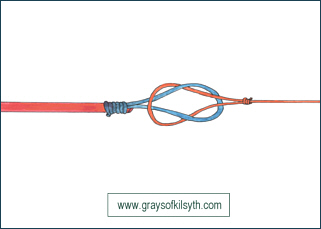
|
WATER KNOT
A good dropper knot.
Stronger, more reliable and easier to tie than the blood knot. Although the typical advice
is for three turns, I often use only two turns and the resultant knot seems quite
reliable. Note that the length used for the dropper should be the one pointing away from
the reel.
1 With the "reel end" to your
right, cut the leader at the point where the dropper is required and overlap the ends by
about 10 inches, depending on the length of dropper .
2 Form an overhand loop with the doubled nylon and grip firmly
at point "A" with the right thumb and forefinger.
3 With the left hand, pull the dropper length along with the
whole lower section of the leader through the loop at least twice.
4 Moisten, draw tight and trim the end which points towards the
reel.
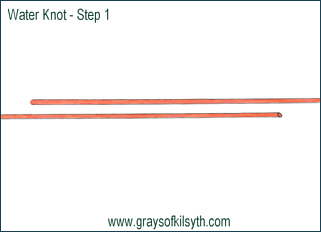
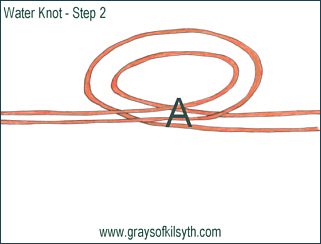
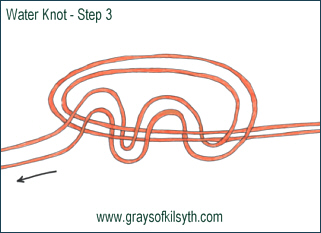
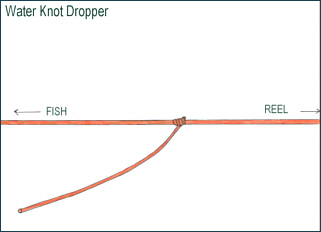
|
|
|